Looking for a Thai escape but unsure of where to go in Thailand? Well, you’re in luck! As one of the top tourist destinations in Southeast Asia, Thailand boasts a dazzling array of destinations. From the vibrant, bustling streets of world-famous Bangkok to the serene, culturally rich corners of hidden gems like Chiang Rai, this country always has something special to offer.
Now, we’ve curated a month-by-month guide between May and October, so you know where to go in Thailand during these different times of the year! Are you ready for the perfect Thai getaway?
Also read: Bangkok Public Transport Guide: How to Get Around as a Tourist
Where to go in Thailand from May to October
May: Chiang Mai & Chiang Rai
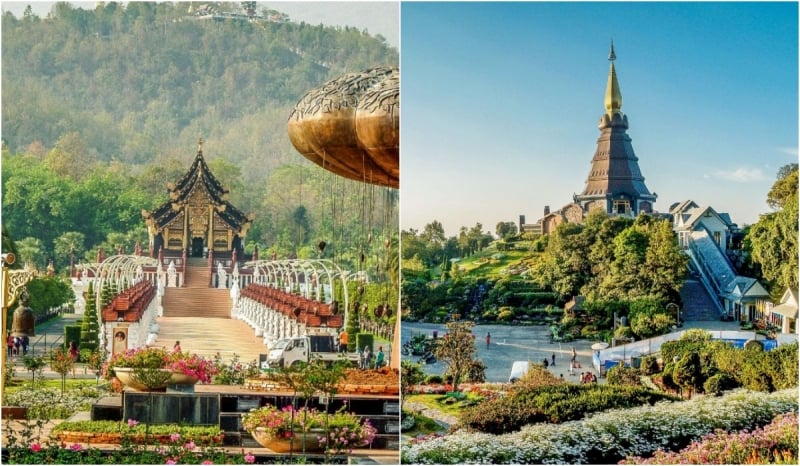
Image credit: icon0.com via CanvaPro
For a refreshing escape in Thailand, head to Chiang Mai in May! Often considered the shoulder season, May in Chiang Mai offers a unique charm. Early rains begin to sweep through the region, transforming the landscape into a lush, vibrant green. With cooler temperatures easing the heat of previous months and fewer crowds around, it’s the perfect time to explore at your own pace.
Surrounded by lush landscapes, Chiang Mai is perfect for trekking and chasing waterfalls at Doi Inthanon National Park. Don’t miss out on attractions like Wat Phrathat Doi Kham, Watchediluang Varaviharn, Tha Phae Gate, as well as the iconic Chiang Mai Night Safari, too!
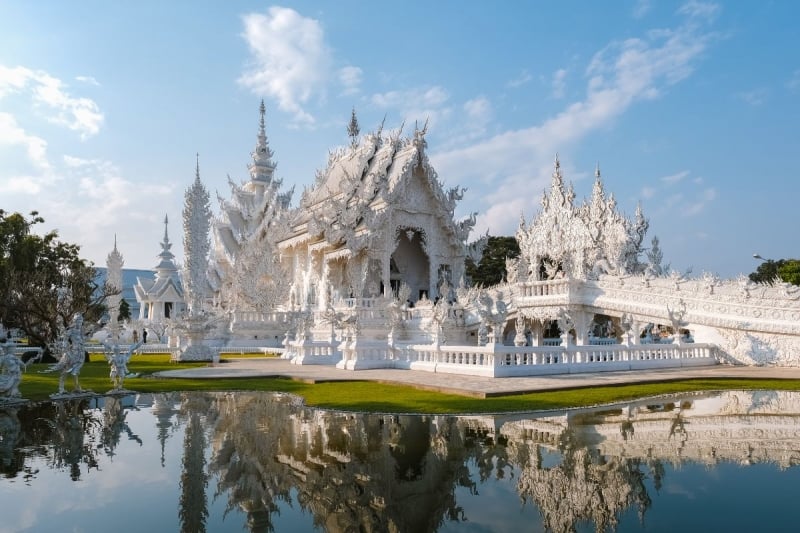
Image credit: Chirapriya Thanakonwirakit via Canva Pro
Extend your Northern Thailand adventure to Chiang Rai, located just a short journey away. Both cities are steeped in history through their shared heritage as cornerstones of the ancient Lanna Kingdom. After all, both cities served as capitals during different periods of this powerful northern Thai kingdom, which flourished for centuries before its eventual decline. The shared history of the two cities is best seen through the similar yet distinct architecture and their shared Lanna cultural roots.
Like Chiang Mai, May in Chiang Rai ushers in the refreshing change of the shoulder season. The region bursts into verdant life, offering a cooler and more serene atmosphere. With fewer tourists, you’ll have the space to truly appreciate its artistic and cultural wonders. Explore the captivating White Temple (Wat Rong Khun), the intriguing Blue Temple (Wat Rong Suea Ten), and the mystical Black House (Baan Dam Museum). For a taste of nature, venture to the Doi Chang mountain range for its renowned coffee plantations and stunning vistas.
Getting there from Singapore:
You can hop on a direct flight to Chiang Mai from Singapore with Scoot (approximately three hours). Alternatively, you can fly into Bangkok and take the train to Chiang Mai. The best way to travel between Chiang Mai and Chiang Rai is by bus or private transfer.
June: Lamphun & Lampang
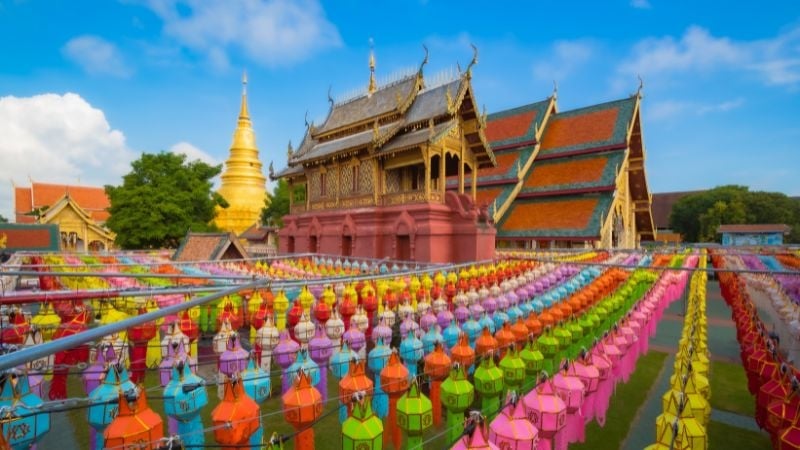
Image credit: TAT Media Assets
If you wish to delve even deeper into the fascinating history of Northern Thailand, consider visiting Lamphun and Lampang.
Often overlooked by travellers, Lamphun holds the distinction of being the oldest continuously inhabited city in Thailand and the former capital of the Hariphunchai Kingdom, a Mon civilisation that predated the Lanna.
Start by visiting the Wat Phra That Hariphunchai Woramahawihan. This magnificent temple, with its gleaming golden chedi, is the spiritual heart of the province and a testament to its ancient royal past. Just a short stroll away, the Hariphunchai National Museum offers a deeper dive into the region’s history, housing a remarkable collection of artefacts from the Dvaravati and Hariphunchai periods. Meanwhile, for a peaceful escape, wander through the Lamphun Provincial Hall and the surrounding gardens.
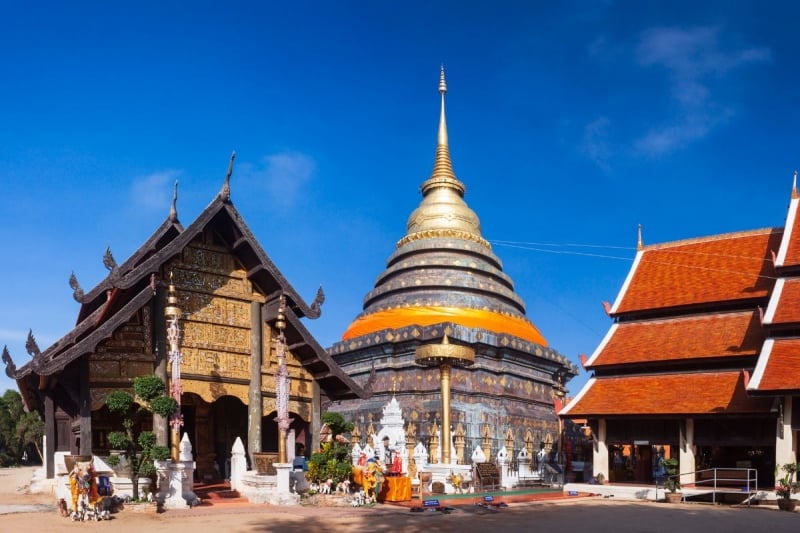
Image credit: voranat via Canva Pro
A short journey from Lamphun brings you to Lampang, the last capital of the Lanna Kingdom, and a city renowned for its horse-drawn carriages.In Lampang, a visit to Wat Phra Kaeo Don Tao Suchadaram is a must. This temple once housed the revered Emerald Buddha before it moved to Chiang Rai and then Bangkok, a powerful symbol of the shared religious and political history connecting these northern cities.
Another architectural gem is Wat Phra That Lampang Luang, an impressive fortified temple complex considered one of the finest examples of Lanna architecture in Thailand. Its imposing walls and ancient chedi are a sight to behold. For a unique experience, take a leisurely horse-drawn carriage ride through the city’s historic centre, marvelling at the well-preserved teakwood houses and colonial-era buildings.
Getting there from Singapore:
The easiest way to reach this area of Northern Thailand is to first take a direct flight from Singapore to Bangkok, and then hop on a domestic flight to Lampang. The whole journey takes about four to five hours. You could also take a sleeper train from Bangkok to Lampang for a more memorable experience, but the train journey itself could take up to 12 hours.
Alternatively, you can first fly to Chiang Mai and take a bus to Lamphun (approximately 45 minutes).
July: Koh Samui & Surat Thani
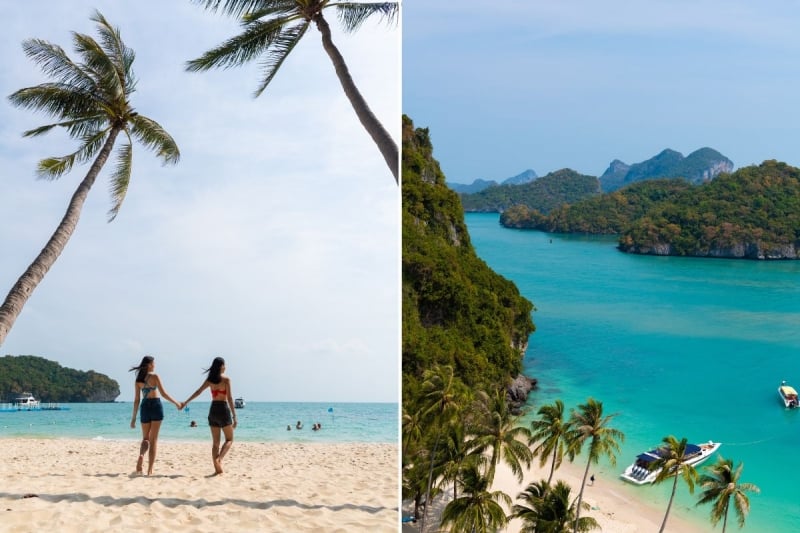
Image credit: TAT Media Assets
Koh Samui is a tropical island in the Gulf of Thailand, known for its palm-fringed beaches, luxury resorts, vibrant nightlife, and laid-back charm. While much of Southern Thailand experiences heavy rainfall, Koh Samui enjoys more sunshine and calm seas in July, making it ideal for beach holidays, island-hopping, and water sports.
There’s no shortage of things to see and do on this gorgeous island. Beyond chilling by the popular beaches like Chaweng and Lamai, visit the Big Buddha Temple (Wat Phra Yai), a golden landmark overlooking the sea, or explore the lush Na Muang Waterfalls tucked in the jungle, too!
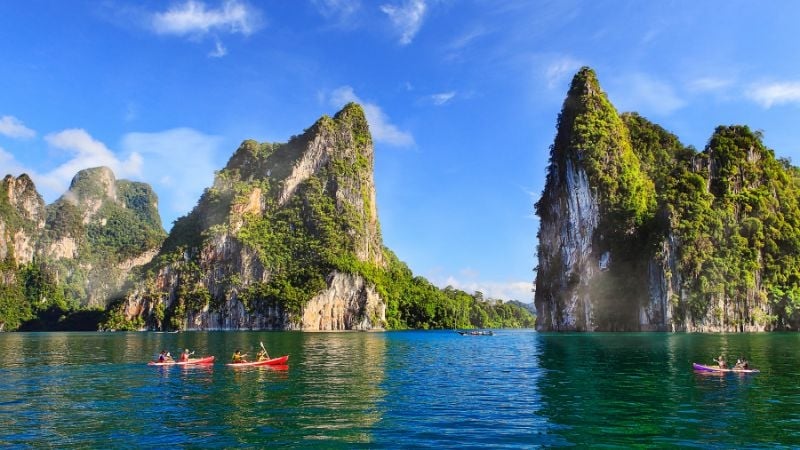
Image credit: TAT Media Assets
While Koh Samui beckons with its island charm, the adjacent mainland province of Surat Thani offers a contrasting yet equally captivating experience. Often dubbed the “City of Good People”, Surat Thani serves as a vital hub for travellers venturing into the Gulf of Thailand and acts as the primary mainland gateway to Koh Samui, with frequent ferry services between the two locations.
The undeniable highlight of Surat Thani is Khao Sok National Park. This ancient rainforest, believed to be even older than the Amazon, is a geological marvel. Imagine towering limestone karsts piercing the sky, verdant jungle canopies teeming with wildlife, and the serene emerald waters of Cheow Lan Lake.
Here, you can immerse yourself in nature with activities like jungle trekking, searching for the colossal Rafflesia flower, or embarking on a thrilling night safari to spot elusive nocturnal creatures. You can even stay in a floating raft house on Cheow Lan Lake!
Getting there from Singapore:
Getting to Koh Samui and Surat Thani from Singapore is easy, as there are flights to both destinations. Flights to Koh Samui are much more convenient and popular, as Airlines like Bangkok Airways and Scoot offer direct flights to Koh Samui.
You can also fly to Surat Thani on AirAsia, however, it usually involves a stopover in Bangkok. Hence, the best way is to fly to Koh Samui and then take the ferry to Surat Thani.
August: Nakhon Si Thammarat & Phatthalung
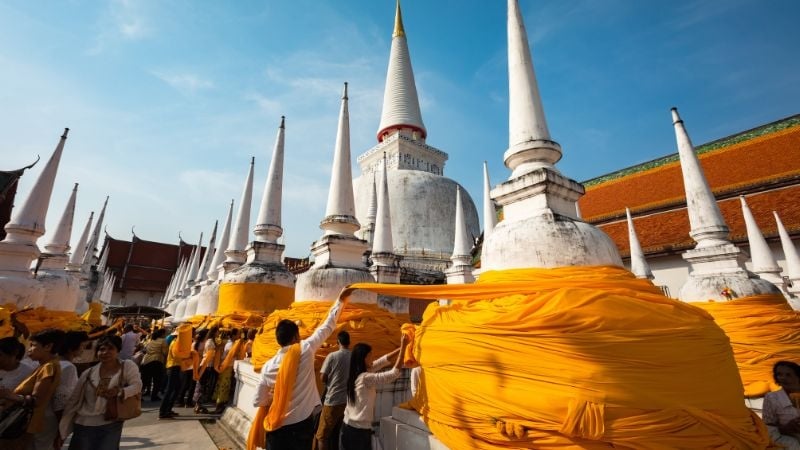
Image credit: TAT Media Assets
For a journey through Southern Thailand that intertwines ancient history with stunning natural beauty, set your sights on Nakhon Si Thammarat and Phatthalung. These two provinces, steeped in rich heritage and offering diverse landscapes, present a captivating experience that showcases their enduring connection.
Nakhon Si Thammarat is one of Thailand’s oldest and most historically significant cities, a former powerful kingdom that once dominated the Malay Peninsula. Start by visiting Wat Phra Mahathat Woramahawihaan. This magnificent temple, with its gleaming golden chedi, is one of the most revered Buddhist sites in Southern Thailand and is believed to house a tooth relic of the Buddha, making it a crucial pilgrimage destination.
On the other hand, for a serene escape into nature, head to Kiriwong Village, nestled at the foot of the Khao Luang mountain range. If a coastal breeze calls your name, Sichon Beach offers a more laid-back alternative to the bustling tourist hotspots, with its tranquil shores, local seafood eateries, and a genuine Southern Thai charm.
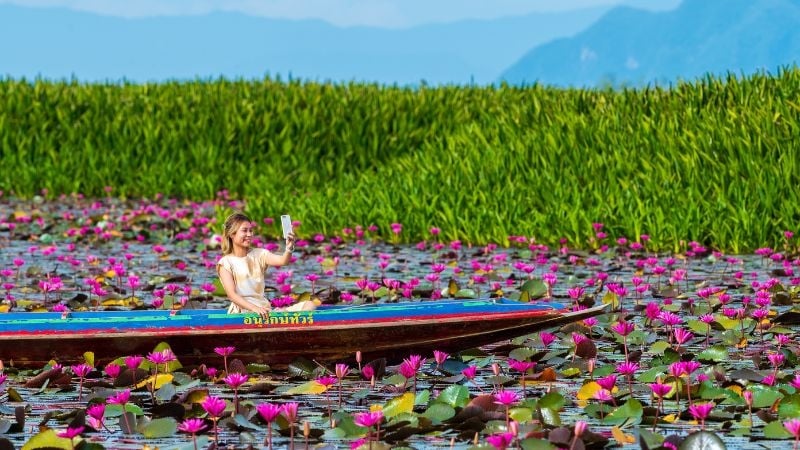
Image credit: TAT Media Assets
Just a short distance away lies Phatthalung, a province renowned for its dramatic limestone karsts and vast wetlands. A relatively hidden gem, Phatthalung is famously picturesque, with its unique “Khao Ok Thalu,” a distinctive mountain with a hole through it, being an iconic symbol.
One of the must-visit locations in this region is Nai Dong Bon, known for its charming cafes and rural landscapes. It provides glimpses of daily life amidst the striking natural backdrop of limestone mountains, offering a peaceful retreat and chances to enjoy local delicacies. If you’re in the hunt for picturesque scenery to light up your Instagram feed, make sure to visit Thale Noi, which is famous for its stunning wetland vistas.
Getting there from Singapore:
Travelling to either Nakhon Si Thammarat or Phatthalung requires a domestic flight departing from Bangkok. So, you’ll want to first fly to either Suvarnabhumi – BKK or Don Mueang – DMK, and then hop on a domestic flight to Nakhon Si Thammarat (around 1.5 hours). If you’re travelling to Phatthalung first, you’ll need to fly from Bangkok to Hatyai (also around 1.5 hours), and then take ground transport to Phatthalung.
September: Sukhothai & Phitsanulok
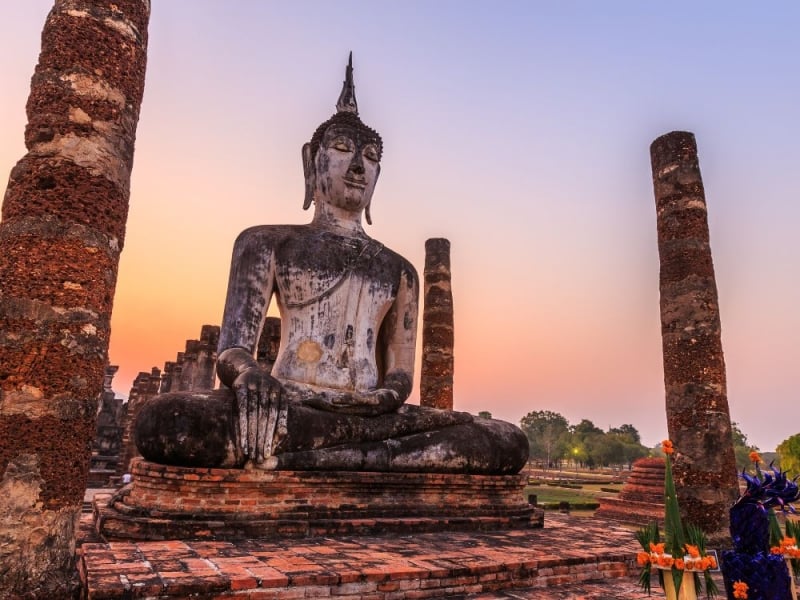
Image credit: AvigatorPhotographer from Getty Images via CanvaPro
Thinking of where to go in Thailand but dislike the crowds? We’ve got you. Sukhothai is a hidden gem to consider for September travel in Thailand, especially if you’re into culture, history, and fewer tourist crowds. Though it’s still rainy season in central Thailand, in Sukhothai, the rain typically comes in short bursts, leaving the air fresh and the landscapes beautifully lush.
Explore Sukhothai Historical Park, a UNESCO World Heritage Site featuring stunning temple ruins and serene lotus ponds that will bring you back to the 13th and 14th centuries. At the heart of the park is Wat Mahathat, known for its iconic lotus-bud stupa and rows of standing Buddha images. Nearby, Wat Si Chum impresses visitors with its massive seated Buddha, Phra Achana, partially hidden within a tall, narrow mondop. It’s perfect for pictures!
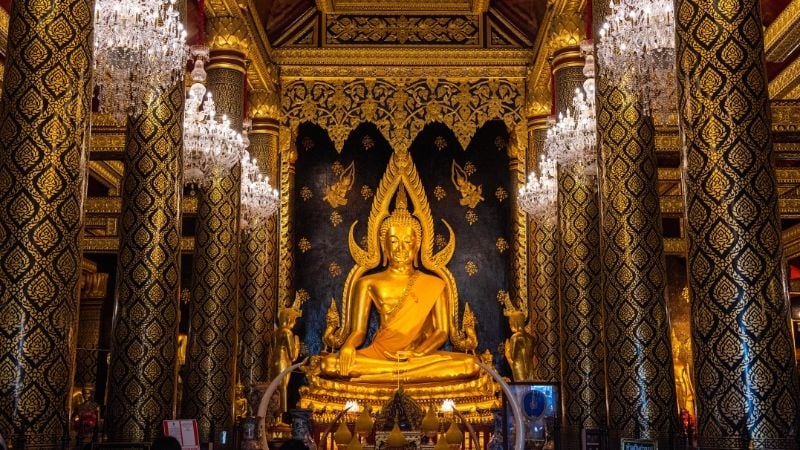
Image credit: TAT Media Assets
While Sukhothai offers historical charm, consider its equally fascinating neighbour, Phitsanulok, a city steeped in history and often referred to as “Mueang Song Kwae” (City of Two Rivers) due to its position at the confluence of the Nan and Khwae Noi rivers.
The main attraction of Phitsanulok is Wat Phra Si Rattana Mahathat Woramahawihan, commonly known as Wat Yai. This magnificent temple houses the Phra Phuttha Chinnarat, a Buddha image widely regarded as one of the most beautiful in Thailand. For a glimpse into the city’s military past and the life of a revered king, visit the King Naresuan the Great Shrine, which honours the legendary Ayutthaya monarch who was born and grew up in Phitsanulok. Meanwhile, for a taste of local life, explore the Phitsanulok Night Bazaar along the Nan River, offering a vibrant atmosphere, delicious street food, and local handicrafts.
Fun fact: Phitsanulok served as a major strategic and administrative city during the Sukhothai Kingdom. Both Phitsanulok and Sukhothai represent a glorious period of Thai history, showcasing exquisite ancient craftsmanship and a profound spiritual heritage. Visiting them together allows for a more complete understanding of the evolution of Thai civilisation in the central plains.
Getting there from Singapore:
The easiest way to get to this part of Thailand is to hop on a direct flight to Bangkok from Singapore and then transfer onto a domestic flight to Sukhothai (one hour and 15 minutes) or Phitsanulok (one hour).
October: Phuket & Phang Nga
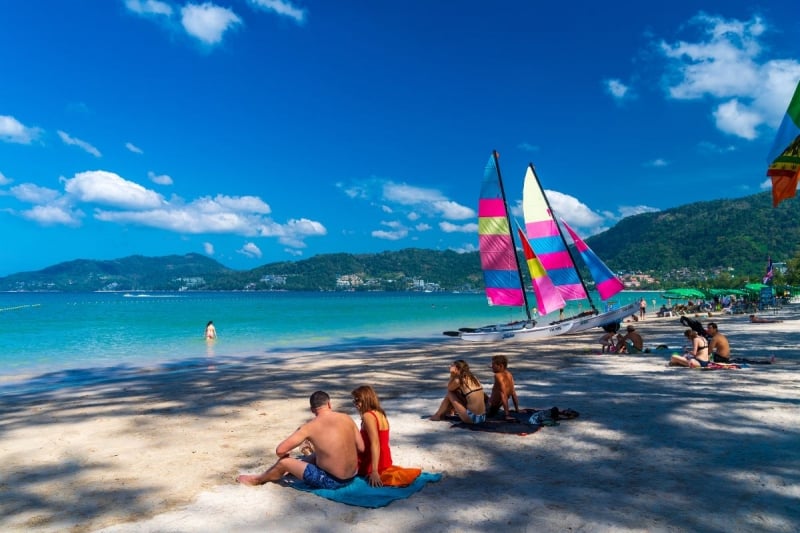
Image credit: TAT Media Assets
October is when the rainy season begins to taper off. And you know what it means — it’s time to visit the beach! While you may still encounter occasional showers, they’re often short and refreshing, with more sunny breaks.
Don’t miss out on stunning beaches like Patong, Kata, and Karon, where you can relax on soft sands and soak up the tropical sun, or indulge in activities like surfing! For those seeking adventure, island hopping tours to nearby gems such as the iconic Phi Phi Islands and the cinematic James Bond Island offer crystal-clear waters, snorkelling, and breathtaking scenery.
October is also culturally vibrant with Phuket’s Vegetarian Festival, a week-long event featuring colourful street processions, spiritual rituals, and a lively celebration of Thai-Chinese culture!
Looking for a more underrated sun-kissed destination in Thailand? Then consider a visit to Phang Nga, Phuket’s lesser-known but equally enticing neighbour. The province lies directly to the north of Phuket, with the iconic Sarasin Bridge connecting the two locations.
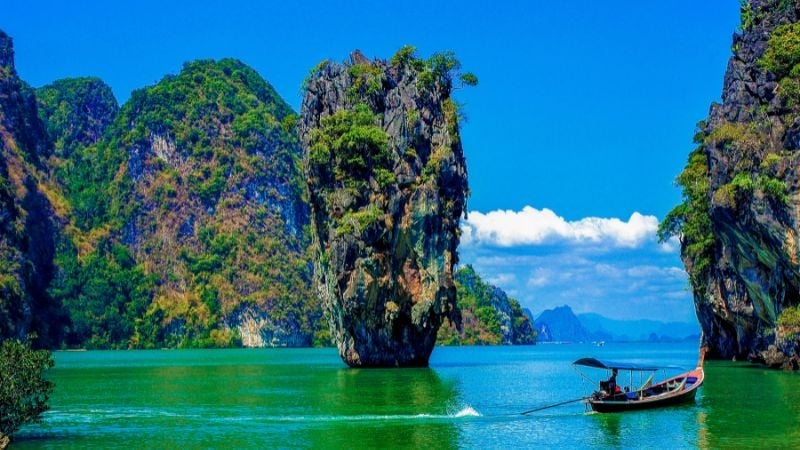
Image credit: TAT Media Assets
Simply put, Phang Nga is a paradise for nature lovers, adventurers, and those seeking iconic landscapes away from the bustling crowds. Its most famous attraction is Phang Nga Bay, which offers a truly breathtaking landscape dotted with hundreds of limestone islets, caves, and hidden lagoons. The bay is best known for its awe-inspiring limestone karsts that spectacularly emerge from the emerald waters, a spectacular view that always draws crowds, even during the shoulder seasons. Another natural wonder worth exploring is Tham Samnak Tham Waterfall or Sa Nang Manora Forest Park, offering refreshing dips in natural pools amidst lush jungle.
For a more serene and pristine beach experience, head to Natai Beach. This long, tranquil stretch of golden sand is known for its luxurious boutique resorts and peaceful atmosphere, offering a perfect escape to unwind and soak up the sun without the throngs
Getting there from Singapore:
Plenty of airlines, including Scoot and AirAsia, offer direct flights from Singapore to Phuket, which takes about two hours. Once you arrive in Phuket, you can easily travel between Phuket and Phang Nga on land transport like buses and minivans.
Also read: 20 Best Places to Visit in Bangkok, As Recommended by This Expat
So here you go, a guide on where to go in Thailand between May and October. From island hopping in Phuket and Phang Nga and enjoying cool breezes in Chiang Mai and Chiang Rai, to soaking up island vibes in Koh Samui and Surat Thani, Thailand offers something for everyone! Ready to say sawasdeeka and begin your adventure in the Land of Smiles?
Brought to you by the Tourism Authority of Thailand.




